康复机器人项目简介
康复机器人技术在康复中的应用
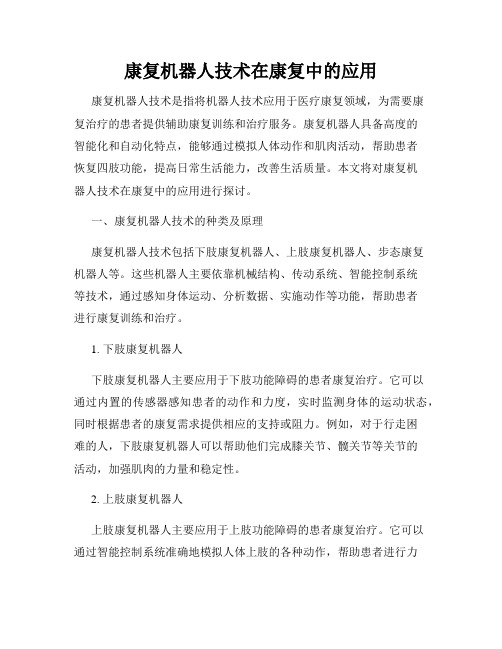
康复机器人技术在康复中的应用康复机器人技术是指将机器人技术应用于医疗康复领域,为需要康复治疗的患者提供辅助康复训练和治疗服务。
康复机器人具备高度的智能化和自动化特点,能够通过模拟人体动作和肌肉活动,帮助患者恢复四肢功能,提高日常生活能力,改善生活质量。
本文将对康复机器人技术在康复中的应用进行探讨。
一、康复机器人技术的种类及原理康复机器人技术包括下肢康复机器人、上肢康复机器人、步态康复机器人等。
这些机器人主要依靠机械结构、传动系统、智能控制系统等技术,通过感知身体运动、分析数据、实施动作等功能,帮助患者进行康复训练和治疗。
1. 下肢康复机器人下肢康复机器人主要应用于下肢功能障碍的患者康复治疗。
它可以通过内置的传感器感知患者的动作和力度,实时监测身体的运动状态,同时根据患者的康复需求提供相应的支持或阻力。
例如,对于行走困难的人,下肢康复机器人可以帮助他们完成膝关节、髋关节等关节的活动,加强肌肉的力量和稳定性。
2. 上肢康复机器人上肢康复机器人主要应用于上肢功能障碍的患者康复治疗。
它可以通过智能控制系统准确地模拟人体上肢的各种动作,帮助患者进行力量训练、运动协调等康复训练。
同时,上肢康复机器人还可以提供实时反馈,帮助患者掌握正确的动作技巧,加速康复进程。
3. 步态康复机器人步态康复机器人主要应用于下肢功能障碍的患者康复治疗。
它可以通过智能控制系统模拟人体正常的步态,并根据患者的特殊需求进行调整。
步态康复机器人不仅可以帮助患者进行步态模拟训练,还可以通过实时调整步态参数,提供恰当的支持和阻力,帮助患者恢复正常的行走能力。
二、康复机器人技术的优势康复机器人技术在康复治疗中有着显著的优势,主要表现在以下几个方面:1. 个性化治疗康复机器人技术可以根据患者的病情和康复需求,进行个性化的治疗方案。
通过对患者进行初步评估,机器人可以根据患者的身体特点和康复目标,选择合适的训练参数和康复模式,推动患者的快速康复。
2. 精确度高康复机器人技术通过内置的传感器和智能控制系统,可以实时监测和分析患者的运动状态,提供精确的运动支持和协调。
康复机器人概述
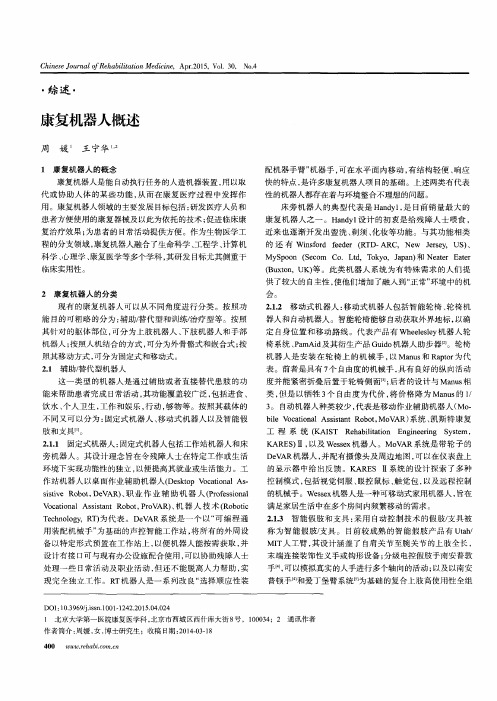
DOI:10.3969 ̄.issn.1001—1242.2015.04.024 1 北京 大学第 一医院康复医学科 ,北 京市西城 区西什库大街 8号,100034;2 通讯作者 作者 简介 :周媛 ,女 ,博士研 究生 ;收稿 日期 :2014—03.18
2 康 复 机 器 人 的 分 类 现有 的康复 机器人可 以从不 同角度进行 分类 。按 照功
能 目的可粗 略的分为 :辅助/替代型 和训练/治疗 型等 。按照 其针 对 的躯体 部位 ,可分 为上肢机器人 、下 肢机器人 和手部 机器人 ;按照人机结合 的方式 ,可分为外骨骼式和嵌合式 ;按 照其 移动方式 ,可分 为固定式和移动式 。 2.1 辅助/替代 型机器人
配机器手 臂”机 器手 ,可在水平 面 内移动 ,有结 构轻便 、响应 快的特点 ,是许 多康复机器人项 目的基础 。上述两类有代表 性的机器人都存在着与环境整合 不理想的问题 。
床旁 机器 人 的典 型代 表是 Handyl,是 目前 销量 最大 的 康 复机器 人之一 。Handy1设 计 的初衷 是给残 障人士 喂食 , 近来 也逐渐开 发出盥洗 、剃须 、化妆 等功能 。与其功能相 类 的 还 有 Winsford feeder (RTD—ARC,New Jersey, us)、 MySpoon (Secom Co.Ltd,Tokyo,Japan)和 Neater Eater (Buxton,UK)等 。此类 机器 人系统 为有特 殊需 求的 人们 提 供了较大 的自主性 ,使他 们增 加了融人到“正常”环境 中的机 会 。 2.1.2 移 动式机器人 :移 动式机器人 包括智 能轮椅 、轮椅 机 器人和 自动机器人 。智 能轮椅 能够 自动获取外 界地 标 ,以确 定 自身位置 和移动路 线 。代 表产 品有 Wheelesley机 器人 轮 椅系统 、PamAid及其衍 生产品 Guido机器人助 步器 】。轮 椅 机 器人 是安 装在 轮椅 上 的机 械手 ,以 Manus和 Raptor为代 表 。前 者是具有 7个 自由度 的机械手 ,具有 良好 的纵 向活动 度并 能紧密折叠 后置 于轮 椅侧 面 1;后 者的设计 与 Marius相 类 ,但是 以牺牲 3个 自由度 为代价 ,将 价格 降为 Manus的 1/ 3。 自动机 器人种类较少 ,代表 是移 动作业辅 助机器人 (Mo. bile Vocational Assistant Robot,MoVAR)系统 、凯斯 特康复 工 程 系 统 (KAIST Rehabilitation Engineering System, KARES)II,以及 Wessex机器人 。MoVAR系统 是带 轮子 的 DeVAR机器人 ,并 配有摄像头及 周边 地图 ,可以在仪表盘 上 的显示器 中给 出反馈 。KARES Ⅱ系统 的设 计探 索 了多种 控制模 式 ,包括视觉伺 服 、眼控 鼠标 、触觉 包 ,以及远程控 制 的机械手 。Wessex机器人是一种可 移动 式家用机器人 ,旨在 满 足家居生 活中在多个房 间内频繁移动 的需求 。 2.1.3 智能假 肢 和支具 :采 用 自动 控制技 术 的假 肢/支 具被 称为智 能假 肢伎 具 。 目前较成 熟 的智 能假肢 产 品有 Utah/ MIT人 工臂 ,其设计 涵盖 了 自肩 关节 至腕关节 的上肢全长 , 末端连接装饰性义手或钩形设备 ;分级 电控假肢手南安普敦 手 ,可以模 拟真实的人手进行 多个 轴向的活动 ;以及 以南安 普顿手i41和爱丁堡 臂系统 1为基础 的复合上 肢高使用性 全组
医学机器人分类
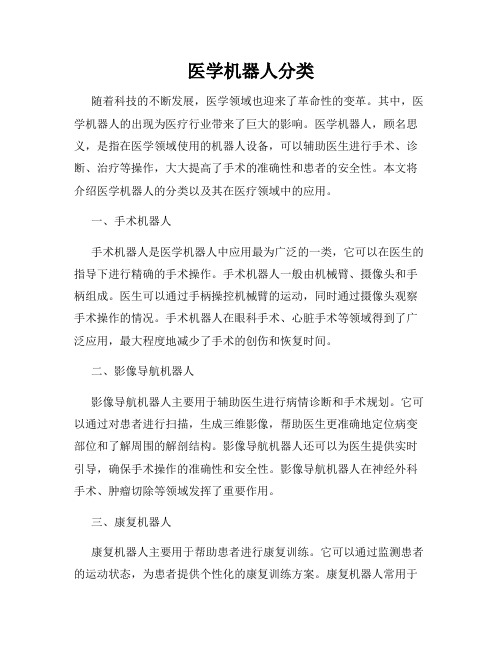
医学机器人分类随着科技的不断发展,医学领域也迎来了革命性的变革。
其中,医学机器人的出现为医疗行业带来了巨大的影响。
医学机器人,顾名思义,是指在医学领域使用的机器人设备,可以辅助医生进行手术、诊断、治疗等操作,大大提高了手术的准确性和患者的安全性。
本文将介绍医学机器人的分类以及其在医疗领域中的应用。
一、手术机器人手术机器人是医学机器人中应用最为广泛的一类,它可以在医生的指导下进行精确的手术操作。
手术机器人一般由机械臂、摄像头和手柄组成。
医生可以通过手柄操控机械臂的运动,同时通过摄像头观察手术操作的情况。
手术机器人在眼科手术、心脏手术等领域得到了广泛应用,最大程度地减少了手术的创伤和恢复时间。
二、影像导航机器人影像导航机器人主要用于辅助医生进行病情诊断和手术规划。
它可以通过对患者进行扫描,生成三维影像,帮助医生更准确地定位病变部位和了解周围的解剖结构。
影像导航机器人还可以为医生提供实时引导,确保手术操作的准确性和安全性。
影像导航机器人在神经外科手术、肿瘤切除等领域发挥了重要作用。
三、康复机器人康复机器人主要用于帮助患者进行康复训练。
它可以通过监测患者的运动状态,为患者提供个性化的康复训练方案。
康复机器人常用于中风患者、运动障碍患者等对运动功能有一定程度损害的人群中。
康复机器人既可以陪伴患者进行康复训练,又可以记录患者的康复进展,为医生提供参考依据。
四、药物分发机器人药物分发机器人可以自动完成药物的分发工作。
它可以根据医生的处方,按时准确地分发药物给患者。
药物分发机器人可以大大提高药物的准确性和速度,减少药物误配的风险。
此外,药物分发机器人还能够对患者的用药记录进行管理,为医生提供用药依据和参考。
五、护理机器人护理机器人主要用于照顾病患,提供基础护理服务。
它可以通过语音识别和人工智能技术,与病患进行基本交流,并为病患提供日常生活上的帮助,如搬运和喂食等。
护理机器人可以减轻医生和护士的工作负担,使他们能够更好地专注于病情研究和治疗。
下肢康复机器人PPT

下肢康复机器人的研究涉及多个学科领域 ,需要加强跨学科的合作与交流,共同推 动下肢康复机器人的发展。
05
下肢康复机器人的未来 发展
技术创新与改进
01
02
03
智能化控制
利用人工智能和机器学习 技术,实现下肢康复机器 人的自主运动控制和个性 化治疗方案。
精准评估
通过传感器和生物力学分 析,提高下肢康复机器人 的评估准确性和治疗效果。
体育训练
下肢康复机器人也可用于运动员的 体能训练和康复训练,提高运动表 现和预防运动损伤。
02
下肢康复机器人的技术 原理
机器人结构与设计
机器人结构
下肢康复机器人通常由机械腿、驱动 系统、传感器和控制系统等部分组成 ,能够模拟人类下肢的运动,辅助或 替代行走功能。
设计理念
设计下肢康复机器人时需考虑人体工 学、安全性、稳定性和舒适性等因素 ,以确保患者在使用过程中能够得到 有效的康复训练。
下肢康复机器人
目录
• 下肢康复机器人概述 • 下肢康复机器人的技术原理 • 下肢康复机器人的使用方法 • 下肢康复机器人的研究进展 • 下肢康复机器人的未来发展 • 下肢康复机器人的实际应用案例
01
下肢康复机器人概述
定义与特点
定义
下肢康复机器人是一种辅助或替 代传统物理治疗方法的机器人技 术,用于帮助下肢运动功能障碍 患者进行康复训练。
这些案例中发挥了重要作用。
家庭康复的应用案例
随着科技的进步,下肢康复机器人也逐 渐应用于家庭康复领域。家庭康复机器 人能够为患者提供方便、有效的康复训 练,使患者在家中也能进行科学的康复
治疗。
家庭康复机器人通常具有便携、易操作 家庭康复的应用案例还包括针对老年人
下肢外骨骼机器人简介及其在康复领域的应用

下肢外骨骼机器人简介及其在康复领域的应用随着现代科技的快速发展,机器人技术在医学领域的应用越来越广泛,其中下肢外骨骼康复机器人为康复医学中的一项重要创新。
这种高科技设备旨在帮助下肢功能障碍的患者恢复行走能力,提高生活质量。
本文将简单介绍下肢外骨骼康复机器人的原理、应用及其发展前景。
一、原理下肢外骨骼康复机器人是一种穿戴式设备,通过外骨骼结构支撑人体下肢,并可利用电动机、传感器和智能控制系统实现辅助行走。
其结构主要包括以下几个方面:1.外骨骼结构由轻质高强度材料制成,模仿人体下肢骨骼的形态和功能,为患者提供额外的支撑和保护。
2.动力系统通常由电动机或气动装置驱动,通过关节处的传动机构实现多自由度运动,辅助患者完成站立、行走及体位转移等。
3.传感器系统内置多种传感器,如加速度计、陀螺仪、力传感器等,实时监测患者的姿态和运动状态,提供精准的反馈数据。
4.智能控制系统基于人工智能和机器学习算法,能够根据传感器数据实时调整外骨骼的运动模式,确保患者的运动稳定性和舒适性。
二、应用下肢外骨骼康复机器人主要应用于以下几个康复领域:1.神经康复对于卒中、脊豌损伤及脑瘫等导致下肢功能障碍的患者,通过外骨骼机器人进行早期康复训练,有助于神经重塑和功能恢复。
2.骨科康复在下肢骨折、关节置换术后,患者可以借助外骨骼机器人进行步态训练,促进骨骼愈合和肌肉力量的恢复。
3.老年护理随着老龄化社会的到来,许多老年人面临行动不便的问题。
外骨骼机器人可以为他们提供行走辅助,提升生活自理能力。
4.运动训练运动员在康复训练中使用外骨骼机器人,可以精确控制训练强度和动作模式,提高康复效果。
三、优势相比传统康复方法,下肢外骨骼康复机器人具有多项显著优势:1.提高康复效率通过精确的运动控制和数据反馈,显著缩短康复周期。
2.标准化训练通过标准化的程序,对同一类疾病,不同机构及不同治疗师采用标准方案实施治疗,实现训练方案的同质化。
3.数据追踪实时记录患者的康复数据,便于医生评估康复进展和调整治疗方案。
医疗机器人的康复辅助技术
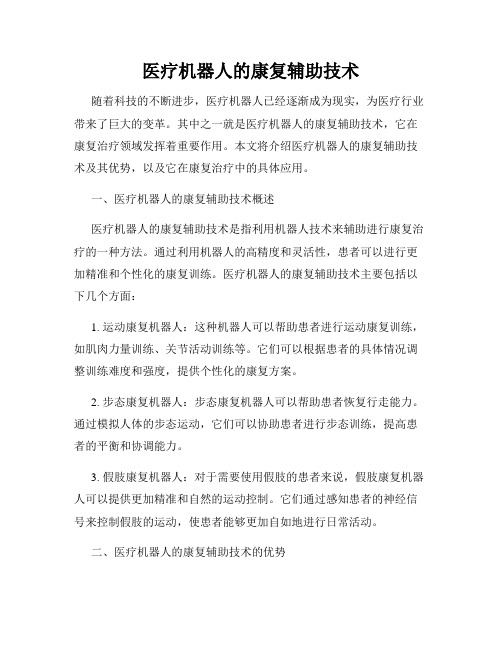
医疗机器人的康复辅助技术随着科技的不断进步,医疗机器人已经逐渐成为现实,为医疗行业带来了巨大的变革。
其中之一就是医疗机器人的康复辅助技术,它在康复治疗领域发挥着重要作用。
本文将介绍医疗机器人的康复辅助技术及其优势,以及它在康复治疗中的具体应用。
一、医疗机器人的康复辅助技术概述医疗机器人的康复辅助技术是指利用机器人技术来辅助进行康复治疗的一种方法。
通过利用机器人的高精度和灵活性,患者可以进行更加精准和个性化的康复训练。
医疗机器人的康复辅助技术主要包括以下几个方面:1. 运动康复机器人:这种机器人可以帮助患者进行运动康复训练,如肌肉力量训练、关节活动训练等。
它们可以根据患者的具体情况调整训练难度和强度,提供个性化的康复方案。
2. 步态康复机器人:步态康复机器人可以帮助患者恢复行走能力。
通过模拟人体的步态运动,它们可以协助患者进行步态训练,提高患者的平衡和协调能力。
3. 假肢康复机器人:对于需要使用假肢的患者来说,假肢康复机器人可以提供更加精准和自然的运动控制。
它们通过感知患者的神经信号来控制假肢的运动,使患者能够更加自如地进行日常活动。
二、医疗机器人的康复辅助技术的优势医疗机器人的康复辅助技术相比传统的康复治疗方法具有以下几个优势:1. 精准性:机器人可以提供更加精准和准确的力量和运动控制,从而实现更加精细的康复治疗。
患者可以根据自身情况进行个性化的治疗,提高治疗效果。
2. 重复性:机器人可以进行长时间的重复训练,提供更大的治疗剂量。
这对于一些需要进行大量重复训练的疾病来说尤为重要,如中风后的康复训练。
3. 安全性:机器人可以提供更加安全的治疗环境。
它们具有高度的稳定性和安全保护机制,能够避免患者在康复训练中受到伤害。
三、医疗机器人的康复辅助技术的应用医疗机器人的康复辅助技术在康复治疗中有着广泛的应用。
以下是几个典型的应用场景:1. 中风康复:机器人可以帮助中风患者进行肌肉力量训练和步态康复训练,促进中风患者的康复恢复。
认识康复机器人实训报告

一、引言随着科技的飞速发展,机器人技术在各个领域得到了广泛应用。
康复机器人作为机器人技术的一个重要分支,近年来在我国逐渐兴起。
为了更好地了解康复机器人的技术原理、应用领域和发展趋势,我们开展了康复机器人实训。
本文将对实训过程进行总结,并对康复机器人的未来发展进行展望。
二、实训内容1. 康复机器人概述首先,我们对康复机器人进行了全面了解。
康复机器人是一种集成了传感器、执行器、控制系统等部件的智能设备,主要用于帮助患者进行康复训练。
与传统康复训练方法相比,康复机器人具有以下优势:(1)个性化:可根据患者的具体需求制定个性化的康复训练方案。
(2)精准化:机器人能够精确控制患者的运动轨迹,提高康复训练的准确性。
(3)智能化:机器人可自动调整训练强度和频率,提高康复训练的效率。
2. 康复机器人技术原理在实训过程中,我们学习了康复机器人的技术原理。
康复机器人主要由以下三个部分组成:(1)传感系统:用于实时监测患者的运动状态,如位置、速度、角度等。
(2)控制系统:根据传感系统收集到的数据,对执行器进行控制,实现康复训练。
(3)执行器:负责执行康复训练动作,如关节活动、肌肉拉伸等。
3. 康复机器人应用领域康复机器人在多个领域得到了广泛应用,主要包括:(1)神经系统康复:如脑卒中、帕金森病、脊髓损伤等。
(2)骨科康复:如骨折、关节置换、关节损伤等。
(3)康复评估:如肌力、关节活动度、平衡能力等。
4. 康复机器人发展现状及趋势康复机器人作为一项新兴技术,在我国发展迅速。
目前,我国康复机器人市场主要集中在以下方面:(1)产品种类丰富:从简单的关节活动辅助机器人到复杂的全身康复机器人,产品种类日益丰富。
(2)技术不断突破:传感器技术、控制系统、驱动系统等方面的技术不断取得突破。
(3)商业化进程加快:越来越多的企业开始关注康复机器人市场,商业化进程不断加快。
未来,康复机器人发展趋势如下:(1)适应范围拓宽:从上肢、下肢、关节、手部等部位,逐步扩展到脊柱、心脏等部位。
简述下肢康复机器人的现状关键技术及发展
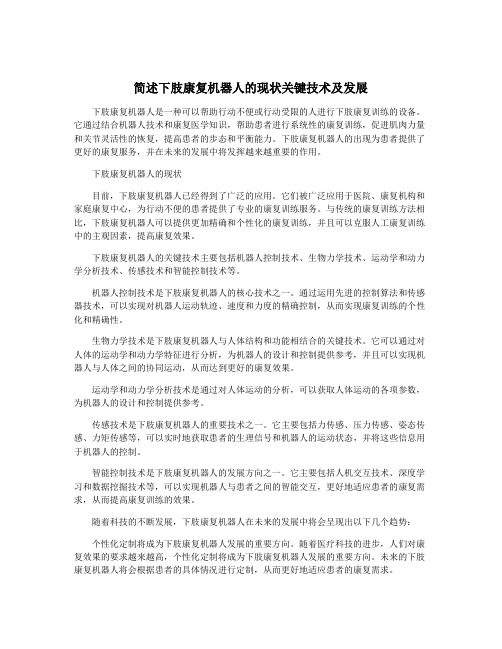
简述下肢康复机器人的现状关键技术及发展下肢康复机器人是一种可以帮助行动不便或行动受限的人进行下肢康复训练的设备。
它通过结合机器人技术和康复医学知识,帮助患者进行系统性的康复训练,促进肌肉力量和关节灵活性的恢复,提高患者的步态和平衡能力。
下肢康复机器人的出现为患者提供了更好的康复服务,并在未来的发展中将发挥越来越重要的作用。
下肢康复机器人的现状目前,下肢康复机器人已经得到了广泛的应用。
它们被广泛应用于医院、康复机构和家庭康复中心,为行动不便的患者提供了专业的康复训练服务。
与传统的康复训练方法相比,下肢康复机器人可以提供更加精确和个性化的康复训练,并且可以克服人工康复训练中的主观因素,提高康复效果。
下肢康复机器人的关键技术主要包括机器人控制技术、生物力学技术、运动学和动力学分析技术、传感技术和智能控制技术等。
机器人控制技术是下肢康复机器人的核心技术之一。
通过运用先进的控制算法和传感器技术,可以实现对机器人运动轨迹、速度和力度的精确控制,从而实现康复训练的个性化和精确性。
生物力学技术是下肢康复机器人与人体结构和功能相结合的关键技术。
它可以通过对人体的运动学和动力学特征进行分析,为机器人的设计和控制提供参考,并且可以实现机器人与人体之间的协同运动,从而达到更好的康复效果。
运动学和动力学分析技术是通过对人体运动的分析,可以获取人体运动的各项参数,为机器人的设计和控制提供参考。
传感技术是下肢康复机器人的重要技术之一。
它主要包括力传感、压力传感、姿态传感、力矩传感等,可以实时地获取患者的生理信号和机器人的运动状态,并将这些信息用于机器人的控制。
智能控制技术是下肢康复机器人的发展方向之一。
它主要包括人机交互技术、深度学习和数据挖掘技术等,可以实现机器人与患者之间的智能交互,更好地适应患者的康复需求,从而提高康复训练的效果。
随着科技的不断发展,下肢康复机器人在未来的发展中将会呈现出以下几个趋势:个性化定制将成为下肢康复机器人发展的重要方向。
简述下肢康复机器人的现状关键技术及发展

简述下肢康复机器人的现状关键技术及发展肢体康复机器人是一种应用于下肢康复的机器人系统,其主要目的是帮助受伤或残疾人恢复行走功能。
下肢康复机器人系统包括患者穿戴机器人外骨骼、控制算法、传感器以及康复训练系统等部分。
下肢康复机器人系统的发展离不开以下关键技术:1. 机械结构设计与智能感知技术:下肢康复机器人需要确保良好的机械结构设计,以确保机器人能够支撑患者的体重并提供合适的力量和灵活性。
机器人需要具备智能感知技术,能够准确感知人体运动状态和力矩,以便根据患者的需要进行合适的运动支持。
2. 控制算法:下肢康复机器人的控制算法是实现精确控制的关键。
通过合适的控制算法,机器人能够根据患者的运动意图来调整力矩输出和运动轨迹,从而实现更加人性化和个性化的康复训练。
3. 传感器技术:下肢康复机器人需要使用各种传感器来感知患者的运动状态、力矩和姿态等信息。
典型的传感器包括惯性测量单元(IMU)、压力传感器和电流传感器等。
这些传感器能够提供实时数据,为控制算法提供依据,并实现机器人与患者之间的交互。
4. 康复训练系统:下肢康复机器人需要与康复训练系统结合使用,以实现全面的康复训练。
康复训练系统通常包括虚拟现实技术、力反馈和生物反馈等,能够提供患者需要的运动刺激和反馈,增强康复效果。
下肢康复机器人的发展已经取得了一定的进展,但仍存在一些挑战和困难:1. 精确控制:机器人需要能够精确控制运动轨迹和力矩输出,以满足患者的个性化康复需求。
控制算法的精确度和可靠性仍然需要进一步提高。
2. 穿戴舒适性:机器人外骨骼的设计需要兼顾舒适性和稳定性。
需要解决机器人外骨骼与患者身体的适配和稳定性问题,以防止不适感和不稳定的运动。
3. 心理因素:康复过程中的心理因素对恢复效果有重要影响。
机器人康复系统需要考虑患者的心理需求,提供相应的心理支持和激励。
未来,下肢康复机器人还有很大的发展空间。
随着人工智能、传感器技术和材料科学等领域的进步,机器人的精确度、舒适性和智能化程度将进一步提高。
六自由度外骨骼式上肢康复机器人设计

六自由度外骨骼式上肢康复机器人设计一、概述随着现代医疗技术的不断进步,康复机器人已成为辅助患者恢复肢体功能的重要工具。
六自由度外骨骼式上肢康复机器人作为一种先进的康复设备,旨在通过模拟人体上肢运动,帮助患者实现精准、高效的康复训练。
本文将对六自由度外骨骼式上肢康复机器人的设计进行详细介绍,包括其结构组成、工作原理、控制策略以及临床应用等方面的内容。
六自由度外骨骼式上肢康复机器人是一种可穿戴式的康复设备,能够紧密贴合患者上肢,通过精确控制各关节的运动,实现上肢的全方位康复训练。
该机器人具有六个自由度,可模拟人体上肢的各种复杂运动,为患者提供个性化的康复训练方案。
机器人还配备了智能传感系统,能够实时监测患者的运动状态,为医生提供精准的康复数据,从而优化康复治疗方案。
在结构组成方面,六自由度外骨骼式上肢康复机器人主要包括机械臂、驱动系统、传感系统以及控制系统等部分。
机械臂采用轻质材料制成,具有良好的穿戴舒适性和运动灵活性;驱动系统采用高精度电机,可实现精确、快速的运动控制;传感系统包括多个角度传感器和力传感器,能够实时监测机械臂和患者上肢的运动状态和交互力;控制系统则负责整合传感数据,实现机器人的运动规划和控制。
六自由度外骨骼式上肢康复机器人作为一种先进的康复设备,具有广泛的应用前景和市场需求。
本文旨在通过对该机器人设计的详细介绍,为相关领域的研究人员和技术人员提供参考和借鉴,推动康复机器人技术的不断发展和创新。
1. 上肢康复机器人的研究背景与意义随着人口老龄化的加剧以及各类事故、疾病对人们身体健康的威胁日益显著,上肢功能障碍患者数量呈现出逐年上升的趋势。
这些障碍往往由中风、外伤、神经系统疾病等多种原因引起,严重影响了患者的日常生活和工作能力,给个人、家庭和社会带来了沉重的负担。
寻求一种高效、安全的上肢康复治疗方法显得尤为重要。
在此背景下,上肢康复机器人的研究与应用应运而生,成为了医疗康复领域的重要发展方向。
简述下肢康复机器人的现状关键技术及发展

简述下肢康复机器人的现状关键技术及发展下肢康复机器人是一种应用机械与电子控制技术的康复器械,它以助力运动方式、姿态控制、生物反馈为核心技术,通过智能控制实现对下肢残疾人群的康复训练,大大提高了下肢康复的效率和效果。
下肢康复机器人技术的发展已经进入理论研究到实际应用的阶段,发展趋势具有广阔的应用前景,本文主要介绍下肢康复机器人的现状关键技术及发展。
一、关键技术1、助力运动助力运动是指下肢康复机器人通过智能计算控制肌肉复位及肌肉活动的过程,对残疾人的下肢进行抬起与放下的运动,使康复者在机器人的帮助下实现运动恢复。
实现这一关键技术的方法主要包括力矩控制技术、主动的力矩控制技术和基于位移的控制技术等。
2、姿态控制姿态控制是指下肢康复机器人智能控制康复者的下肢姿态变化,通过计算机的智能控制,监测康复者下肢的运动轨迹,并调整机器人的力矩、速度等参数,来达到配合与指导康复者正确完成下肢运动使康复效果更佳的目的。
现在的姿态控制主要采用位置控制、速度控制、力控制等。
3、生物反馈生物反馈是指下肢康复机器人通过对康复者不同身体部位的生物特征(如肌肉电位、生理指标、体温等)数据的采集和分析,调整康复过程中所需的力大小、速度和运动范围等参数。
通过生物反馈技术,康复者可以更直观地感受到康复的过程和进程,更好的完成康复训练。
4、智能控制下肢康复机器人采用了智能控制技术,通过计算机控制下肢残疾者开展康复训练。
智能控制技术应用了神经网络、遗传算法等技术,能够更加准确地控制运动,同时还可以根据个体康复状态,智能的调整康复参数,提高康复效果。
二、发展1、技术的创新下肢康复技术的创新是关键。
对下肢康复方面的研究已经取得了很多的进展,但是机器人技术的创新还远远没有结束。
需要进一步研究如何优化康复机器人的结构、控制算法等关键技术,提高康复功能和使用体验。
2、多模式集成下肢康复机器人的多模式集成应用是将运动坐标定位系统,生物反馈系统,身体感知系统,智能神经网络等多种康复技术集成在一起。
医疗机器人的种类及应用场景

医疗机器人的种类及应用场景随着科技的发展,医疗机器人已经成为医疗界的一个重要组成部分。
医疗机器人可以帮助医生减轻工作负担,提高诊疗效率,降低因人为操作而带来的误差风险。
本文将介绍几种常见的医疗机器人及其应用场景。
一、手术机器人手术机器人是一种能够在手术过程中取代医生手工操作的机器人。
手术机器人通常采用先进的视觉、计算机和机器学习等技术,能够实现高精度操作,可以在显微镜下进行微小的切割和缝合,避免手术过程中的误伤,提高手术效果。
手术机器人的应用场景十分广泛,广泛用于心脏手术、胆囊摘除、子宫切除等高风险的手术中。
手术机器人的优势在于操作精度高、手术效果好,但是其缺点也比较明显,设备价格昂贵,需要专业维护,且手术机器人也不能适用于所有的手术操作。
二、康复机器人康复机器人是一种能够对病人进行康复训练的机器人。
康复机器人通常采用先进的机器学习、感知技术和控制技术等,能够模拟教练的手臂和手,帮助病人恢复肢体运动功能。
康复机器人的应用场景主要在于对被截肢、中风等导致肢体运动障碍的病人进行康复训练。
康复机器人的优势在于能够提供高质量、持续且定制化的康复训练,但是其缺点也比较明显,设备价格昂贵,操作有一定的技术门槛,同时,康复机器人也不能完全代替人工的康复训练。
三、护理机器人护理机器人是一种能够提供持续的护理服务的机器人。
护理机器人通常采用先进的纳米、机器人、通信和控制技术等,能够为老年人和患有慢性病等的病人提供定制化的护理服务。
护理机器人的应用场景广泛,可以帮助病人测量生命体征、为病人安排用药计划、组织健康活动和提供应急服务等。
护理机器人的优势在于能够提供全天候的护理服务,缓解医疗资源不足的情况,但是其缺点也比较明显,如机器人的维护和升级成本很高,同时,护理机器人也不能完全代替人工的护理服务。
四、药品配送机器人药品配送机器人是一种能够对医院内部的药品进行物流分配的机器人。
药品配送机器人通常采用物流控制系统和地面感知技术,能够实现高效的药品配送。
医疗机器人康复治疗方法

医疗机器人康复治疗方法随着科技的不断进步,人工智能和机器人技术在医疗领域的应用变得越来越广泛。
其中,医疗机器人在康复治疗中发挥着重要的作用。
本文将介绍几种常见的医疗机器人康复治疗方法,以及它们在患者康复中的优势。
1. 运动康复机器人运动康复机器人主要用于神经康复治疗,可帮助患者进行运动训练和康复训练。
这些机器人一般由机械臂、传感器和控制系统组成。
机械臂能够根据患者的运动能力和康复目标进行调整,帮助患者完成各种运动动作。
传感器可以监测患者的运动状态和肌肉活动情况,从而为治疗师提供有关患者康复进展的指导。
控制系统则根据患者的需求进行运动模式的设定和调整。
2. 平衡康复机器人平衡康复机器人主要用于帮助患有平衡障碍的患者进行康复治疗。
这些机器人可以通过模拟真实场景和提供反馈来帮助患者恢复平衡能力。
机器人可以根据患者的平衡能力进行调整,为患者提供定制化的训练方案。
在训练过程中,机器人会记录患者的平衡状态和进展情况,为治疗师提供有价值的数据。
3. 感觉康复机器人感觉康复机器人主要用于恢复患者的触觉和运动感知功能。
这些机器人通常通过模拟触觉和提供反馈来帮助患者重新建立与外界的感觉联系。
机器人可以模拟不同的触觉刺激,并根据患者的反应进行调整。
在康复过程中,机器人可以识别患者的触摸和运动信息,为治疗师提供有关患者康复进展的指导。
4. 认知康复机器人认知康复机器人主要用于帮助患有认知障碍的患者进行康复治疗。
这些机器人可以通过模拟不同认知任务和提供反馈来帮助患者恢复认知能力。
机器人可以为患者提供个性化的认知训练,帮助他们提高记忆、注意力和问题解决能力。
在训练过程中,机器人可以记录患者的表现和进展情况,为治疗师提供有关患者康复进程的信息。
医疗机器人康复治疗方法具有以下优势:首先,机器人康复治疗可以提供个性化的康复方案。
每个患者的康复需求和能力不同,传统的康复治疗无法满足每个患者的个性化需求。
而机器人康复治疗可以根据患者的具体情况进行调整,为每个患者提供针对性的康复方案。
康复治疗中的机器人辅助技术

康复治疗中的机器人辅助技术1. 引言康复治疗是指帮助患者恢复功能和改善生活质量的过程。
传统的康复治疗通常依靠医护人员进行物理治疗、理疗和训练,但这种方式受限于人力和时间,并且往往无法提供个性化的治疗方案。
然而,随着科技的不断进步,机器人辅助技术在康复治疗中的应用开始变得越来越普遍。
本文将探讨康复治疗中的机器人辅助技术,并分别从康复机器人和远程康复机器人两个方面进行讨论。
2. 康复机器人康复机器人是指专门设计用于康复治疗的机器人系统。
它们可以通过智能传感器和算法,根据患者的病情和需要,提供个性化的康复训练方案。
康复机器人可以辅助患者进行身体活动恢复训练,如肢体运动、平衡和步态恢复等。
机器人的智能控制系统可以根据患者的反馈调整训练难度和强度,确保安全和有效性。
康复机器人可以在训练过程中提供准确的反馈和监控,帮助患者正确进行姿势和动作,避免错误的训练姿势导致进一步伤害。
同时,康复机器人还可以记录和分析患者的训练数据,帮助医护人员评估康复进展,进行个性化的调整和优化治疗计划。
这些功能大大提高了康复治疗的效果和效率。
3. 远程康复机器人远程康复机器人是指通过互联网和远程控制技术,医护人员可以远程监控和控制康复机器人的系统。
这种技术不仅可以帮助患者实时获得专业的康复服务,而且可以解决地域和时间的限制,让更多的患者获得及时的康复治疗。
远程康复机器人通过远程视频和音频通讯,医护人员可以与患者进行面对面的康复指导和交流。
远程康复机器人的系统还可以追踪和记录患者的训练数据,医护人员可以根据这些数据进行评估和调整治疗计划。
这种方式可以大大减少患者的负担,特别是那些无法前往医院接受康复治疗的患者。
4. 康复机器人的优势- 个性化治疗:康复机器人可以根据患者的病情和需求提供个性化的康复训练方案,确保治疗的准确性和有效性。
- 安全性提高:康复机器人通过智能控制系统监测和调整训练过程,避免患者因错误姿势而导致的二次伤害。
- 监控与记录:康复机器人可以实时记录和分析患者的训练数据,帮助医护人员评估康复进展和调整治疗计划。
康复护理新技术新项目有哪些

康复护理新技术新项目有哪些引言随着社会发展和人口老龄化的加剧,康复护理的重要性日益凸显。
为了提供更好的康复护理服务,医疗领域不断涌现新技术和新项目。
本文将介绍一些主要的康复护理新技术和新项目,以帮助人们更好地了解康复护理领域的创新进展。
1. 虚拟现实(VR)康复虚拟现实(VR)技术是一种通过计算机生成的模拟环境,使用户能够身临其境地与虚拟世界互动。
在康复护理中,VR技术被广泛应用于帮助康复患者进行运动训练和认知重建。
通过使用VR设备,患者可以进行特定的运动模拟和认知训练,以恢复肢体功能和认知能力。
2. 运动康复机器人运动康复机器人是指能够辅助和提升康复训练效果的机器人设备。
这些机器人通常采用先进的传感器和控制系统,能够模仿人体运动并提供恰当的支持。
运动康复机器人可用于肌肉力量恢复、运动协调训练等康复目标。
3. 脑机接口(BMI)技术脑机接口(Brain-Machine Interface, BMI)技术是一种能够将脑电信号转化为机器可读的指令的技术。
在康复护理中,BMI技术被用于帮助肢体瘫痪患者恢复运动功能。
通过将患者的意愿转化为机器动作,BMI技术能够实现患者通过思想来控制外部设备,例如假肢或轮椅。
4. 先进的康复评估工具康复评估是制定个性化康复计划的重要环节。
近年来,出现了一些先进的康复评估工具,如运动分析系统和智能康复器械。
运动分析系统能够通过传感器捕捉患者的运动数据,并提供详细的分析报告,用于评估患者的康复进展。
智能康复器械则结合了传感器和自适应控制技术,能够根据患者的特定需要调整康复训练的强度和模式。
5. 应用程序和移动设备的康复辅助随着智能手机和平板电脑的普及,许多康复辅助应用程序和功能被开发出来。
这些应用程序和移动设备通过提供个性化的康复训练计划、监测患者的进展和提供康复支持,有助于患者更方便地进行康复训练并增强自我管理能力。
结论随着技术的不断进步,康复护理领域出现了许多新技术和新项目,为康复患者提供了更好的护理服务和治疗效果。
康复创新创业点子
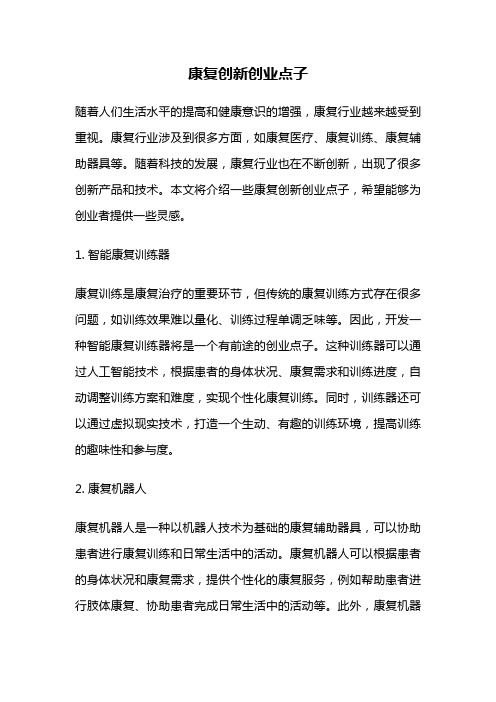
康复创新创业点子随着人们生活水平的提高和健康意识的增强,康复行业越来越受到重视。
康复行业涉及到很多方面,如康复医疗、康复训练、康复辅助器具等。
随着科技的发展,康复行业也在不断创新,出现了很多创新产品和技术。
本文将介绍一些康复创新创业点子,希望能够为创业者提供一些灵感。
1. 智能康复训练器康复训练是康复治疗的重要环节,但传统的康复训练方式存在很多问题,如训练效果难以量化、训练过程单调乏味等。
因此,开发一种智能康复训练器将是一个有前途的创业点子。
这种训练器可以通过人工智能技术,根据患者的身体状况、康复需求和训练进度,自动调整训练方案和难度,实现个性化康复训练。
同时,训练器还可以通过虚拟现实技术,打造一个生动、有趣的训练环境,提高训练的趣味性和参与度。
2. 康复机器人康复机器人是一种以机器人技术为基础的康复辅助器具,可以协助患者进行康复训练和日常生活中的活动。
康复机器人可以根据患者的身体状况和康复需求,提供个性化的康复服务,例如帮助患者进行肢体康复、协助患者完成日常生活中的活动等。
此外,康复机器人还可以通过人工智能技术,学习患者的习惯和喜好,提供更加贴心的服务。
3. 康复智能家居康复智能家居是一种将人工智能技术应用于家居环境中的康复产品。
它可以通过感知患者的身体状况和康复需求,自动调整家居环境,提供更加贴心的生活服务。
例如,当患者需要进行康复训练时,康复智能家居可以自动调整家居环境,提供适合的训练场地和器材;当患者需要进行日常生活中的活动时,康复智能家居可以自动调整家居环境,提供方便的生活设施和服务。
4. 康复社交平台康复社交平台是一种将社交网络和康复行业相结合的创新产品。
它可以为患者提供一个交流、分享、学习和治疗的平台,帮助患者建立康复社交圈,分享康复经验和心得。
此外,康复社交平台还可以为患者提供在线康复咨询和治疗服务,方便患者随时随地获取康复信息和治疗支持。
5. 康复护理服务康复护理服务是一种将护理服务和康复治疗相结合的新型护理服务。
- 1、下载文档前请自行甄别文档内容的完整性,平台不提供额外的编辑、内容补充、找答案等附加服务。
- 2、"仅部分预览"的文档,不可在线预览部分如存在完整性等问题,可反馈申请退款(可完整预览的文档不适用该条件!)。
- 3、如文档侵犯您的权益,请联系客服反馈,我们会尽快为您处理(人工客服工作时间:9:00-18:30)。
矿产资源开发利用方案编写内容要求及审查大纲
矿产资源开发利用方案编写内容要求及《矿产资源开发利用方案》审查大纲一、概述
㈠矿区位置、隶属关系和企业性质。
如为改扩建矿山, 应说明矿山现状、
特点及存在的主要问题。
㈡编制依据
(1简述项目前期工作进展情况及与有关方面对项目的意向性协议情况。
(2 列出开发利用方案编制所依据的主要基础性资料的名称。
如经储量管理部门认定的矿区地质勘探报告、选矿试验报告、加工利用试验报告、工程地质初评资料、矿区水文资料和供水资料等。
对改、扩建矿山应有生产实际资料, 如矿山总平面现状图、矿床开拓系统图、采场现状图和主要采选设备清单等。
二、矿产品需求现状和预测
㈠该矿产在国内需求情况和市场供应情况
1、矿产品现状及加工利用趋向。
2、国内近、远期的需求量及主要销向预测。
㈡产品价格分析
1、国内矿产品价格现状。
2、矿产品价格稳定性及变化趋势。
三、矿产资源概况
㈠矿区总体概况
1、矿区总体规划情况。
2、矿区矿产资源概况。
3、该设计与矿区总体开发的关系。
㈡该设计项目的资源概况
1、矿床地质及构造特征。
2、矿床开采技术条件及水文地质条件。
